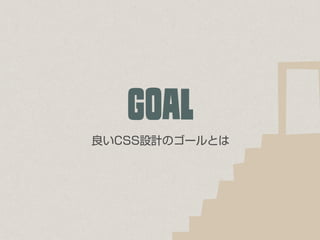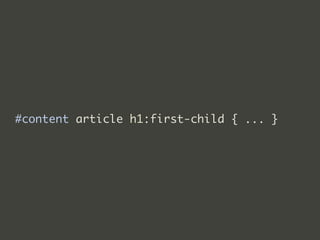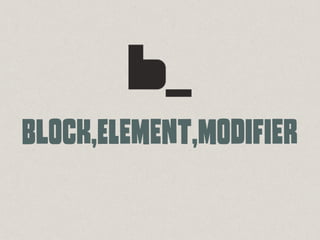Thinking about CSS Architecture
- 4. APp WeB
- 7. q k u
- 8. ¤ ¥
- 9. .text { color: black; } .catchcopy { color: red; } #message .text { color: green; }
- 11. k11l12 9 3 6 10mIn 60mIn...aNd MoRe 11l12 9 3 6 11l12 9 3 6 111 11l12 9 3 6 11l12 9 3 6 11l12 9 3 6 11l12 9 3 6 ¤ ¥
- 12. k 10mIn BUgS... 1 1 1 ±' lll lll H H ±' lll lll H H ±' lll lll H H 11l12 9 3 6 ¤ ¥
- 13. L ?SOmEoNe
- 14. L N ? YOu
- 16. 1CsS
- 17. 1HtMl 1CsS 1Js
- 22. #content article h1:first-child { ... }
- 23. <div id="content"> <article> <h1>Article Title</h1> </article> </div>
- 24. <div id="content"> <section> <h1>Article Title</h1> </section> </div>
- 25. <div id="content"> <article> <p>2013/09/13</p> <h1>Article Title</h1> </article> </div>
- 26. D¤
- 27. .entry-title { ... }
- 28. <div id="content"> <article> <p>2013/09/13</p> <h1 class="entry-title">Article Title</ h1> </article> </div>
- 29. <div id="content"> <div> <p>2013/09/13</p> <h2 class="entry-title">Article Title</ h2> </div> </div>
- 30. POCSSは壊れやすい CsS Is ToO FrAgIlE
- 37. SEpArAtE CoNtAiNeR AnD CoNtEnT SEpArAtE StRuCtUrE AnD SkIn
- 38. SEpArAtE CoNtAiNeR AnD CoNtEnT SEpArAtE StRuCtUrE AnD SkIn
- 39. ®©° MEdIa obJeCt
- 40. <div class="media"> <div class="media-image"> <img src="/img/seminar/15/tani.jpg"> </div> <div class="media-body"> <p>...</p> <ul> <li><a>...</a></li> </ul> <p>...</p> </div> </div>
- 41. <div class="media"> <div class="media-image"> <img src="/img/seminar/15/tani.jpg"> </div> <div class="media-body"> <p>...</p> <ul> <li><a>...</a></li> </ul> <p>...</p> </div> </div>
- 42. <div class="media"> <div class="media-image"> <img src="/img/seminar/15/tani.jpg"> </div> <div class="media-body"> <p>...</p> <ul> <li><a>...</a></li> </ul> <p>...</p> </div> </div>
- 43. .media { overflow: hidden; // Clearfix *zoom: 1; // Clearfix } .media-image { float: left; margin-right: 10px; } .media-image > img { display: block; } .media-body { overflow: hidden; }
- 44. <div class="media skin-a"> <div class="media-image"> <img src="/img/seminar/15/tani.jpg"> </div> <div class="media-body"> <p>...</p> <ul> <li><a>...</a></li> </ul> <p>...</p> </div> </div>
- 45. <div class="media skin-b"> <div class="media-image"> <img src="/img/seminar/15/tani.jpg"> </div> <div class="media-body"> <p>...</p> <ul> <li><a>...</a></li> </ul> <p>...</p> </div> </div>
- 46. SEpArAtE CoNtAiNeR AnD CoNtEnT SEpArAtE StRuCtUrE AnD SkIn
- 47. h2 { font-weight: bold; font-size: 16px; } #news h2 { border-bottom: 1px solid black; padding-bottom: 0.5em; }
- 48. h2 { font-weight: bold; font-size: 16px; } #news h2, #speakers h2 { border-bottom: 1px solid black; padding-bottom: 0.5em; }
- 49. <div id="speakers"> <h1>Hiroki Tani</h1> <h2>Session Title</h2> <div> <p>Summary</p> </div> </div>
- 50. ®©°
- 51. <div id="speakers"> <h1>Hiroki Tani</h1> <h2>Session Title</h2> <div> <p>...</p> </div> <div> <h2>Books</h2> <ul> <li>...</li> </ul> </div> </div>
- 52. <div id="speakers"> <h1>Hiroki Tani</h1> <h2>Session Title</h2> <div> <p>...</p> </div> <div> <h2>Books</h2> <ul> <li>...</li> </ul> </div> </div>
- 53. <div id="speakers"> <h1>Hiroki Tani</h1> <h2>Session Title</h2> <div> <p>...</p> </div> <div> <h2>Books</h2> <ul> <li>...</li> </ul> </div> </div>
- 54. D¤
- 55. h2 { font-weight: bold; font-size: 16px; } .headline { border-bottom: 1px solid black; padding-bottom: 0.5em; }
- 56. <div id="speakers"> <h1>Hiroki Tani</h1> <h2 class="headline">Session Title</h2> <div> <p>...</p> </div> <div> <h2>Books</h2> <ul> <li>...</li> </ul> </div> </div>
- 57. .heading { font-weight: bold; font-size: 16px; } .headline { border-bottom: 1px solid black; padding-bottom: 0.5em; }
- 58. <div id="speakers"> <h1>Hiroki Tani</h1> <h2 class="heading headline">Session Title</h2> <div> <p>...</p> </div> <div> <h2 class="heading">Books</h2> <ul> <li>...</li> </ul> </div> </div>
- 63. ®©°3iF YoU NeEd It. 11
- 65. cAtEgOrIzAtIoN nAmInG CoNvEnTiOn dEcOuPlInG CsS FrOm HtMl
- 67. /* # Base */ body, form { margin: 0; padding: 0; } a { color: #039; } a:hover { color: #03F; }
- 68. /* # Layout */ .l-header, l-article, l-footer { width: 960px; margin: auto; } .l-article { border: solid #CCC; border-width: 1px 0 0; } .l-grid { margin: 0; padding: 0; list-style-type: none; } .l-grid > li { display: inline-block; margin: 0 0 10px 10px; }
- 69. /* # Layout */ #header, #article, #footer { width: 960px; margin: auto; } .l-article { border: solid #CCC; border-width: 1px 0 0; } .l-grid { margin: 0; padding: 0; list-style-type: none; } .l-grid > li { display: inline-block; margin: 0 0 10px 10px; }
- 70. /* # Layout */ .l-container { width: 960px; margin: auto; } .l-article { border: solid #CCC; border-width: 1px 0 0; } .l-grid { margin: 0; padding: 0; list-style-type: none; } .l-grid > li { display: inline-block; margin: 0 0 10px 10px; }
- 71. /* # State */ .is-hidden { display: none; } .is-error { font-weight: bold; color: red; } .is-tab-active { border-bottom-color: transparent; }
- 72. /* # Theme */ /* ## Pink Theme CSS */ .theme-header { background-image: url("/theme/pink/ header.png"); } .theme-border { 1px solid pink; }
- 73. /* # Module */ /* ## Button */ .btn { ... } .btn-primary { ... } .btn-small { ... } /* ## UIlist */ .uilist { ... } .uilist-item { ... } .uilist-item-icon { ... } /* ## Widget */ .widget { ... } .widget-title { ... } .widget-body { ... }
- 74. <button class="btn btn-primary">Submit</button> <a href="/help" class="btn btn-small">Help</a> <button class="btn btn-success btn-large"> Complete! </button>
- 75. <div class="widget"> <h2>Title</h2> <p>Text</p> </div>
- 76. .widget { ... } .widget p { margin-top: 10px; margin-bottom: 10px; }
- 77. <div class="widget"> <h2>Title</h2> <ul> <li>ListItem</li> <li>ListItem</li> <li>ListItem</li> </ul> </div>
- 78. .widget { ... } .widget p, .widget ul { margin-top: 10px; margin-bottom: 10px; }
- 79. <div class="widget"> <h2>Title</h2> <ul class="widget-body"> <li>ListItem</li> <li>ListItem</li> <li>ListItem</li> </ul> </div>
- 80. .widget { ... } .widget-body { margin-top: 10px; margin-bottom: 10px; }
- 81. ®©°>
- 83. ®©° 3, 6, 9, 12, 15 , ‘RUlE Of ThReE’
- 84. ®©° 3, 6, 9, 12, 15 , ‘RUlE Of ThReE’
- 85. ®©° 3, 6, 12, 24, 48 , ‘RUlE Of ThReE’
- 86. ®©° 3, 6, 9, 12, 15 , ‘RUlE Of ThReE’
- 87. ®©°, ‘RUlE Of ThReE’ 3, 6, 9, 12, 15
- 88. ®©°DOnAlD e, knUtH 時期尚早な最適化は 諸悪の根源である。 ... PrEmAtUrE OpTiMiZaTiOn Is ThE RoOt Of AlL EvIl.
- 89. ®©°
- 91. ®©° すべてのセマンティックが コンテンツ派生である必要はない。 ... NoT AlL SeMaNtIcS NeEd To Be CoNtEnT-DeRiVeD. NIcOlAs gaLlAgHeR
- 92. <div class="review"> <h1>CSS Architecture</h1> <p class="reviewer">Review: <span>Hiroki Tani</ span></p> <time datetime="2013-09-14">2013/09/14</time> <p class="review-summary">CSS Bible!</p> <p class="review-description">...</p> Rating: <span class="rating">4.5</span> </div>
- 93. <div itemscope itemtype="http://data- vocabulary.org/Review"> <h1 itemprop="itemreviewed">CSS Architecture</ h1> <p>Review: <span itemprop="reviewer">Hiroki Tani</span></p> <time itemprop="dtreviewed" datetime="2013-09-14">2013/09/14</time> <p itemprop="summary">CSS Bible!</p> <p itemprop="description">...</p> Rating: <span itemprop="rating">4.5</span> </div>
- 95. ®©°311
- 96. /* Sass(.scss) */ %btn { border-radius: 6px; padding: 0.5em 1em; background-color: #CCC; } .btn-primary { @extend %btn; background-image: linear-gradient(...); color: #FFF; }
- 97. /* CSS */ .btn-primary { border-radius: 6px; adding: 0.5em 1em; background-color: #CCC; background-image: linear-gradient(...); color: #FFF; }
- 99. /* Sass(.scss) */ %btn { border-radius: 6px; padding: 0.5em 1em; background-color: #CCC; } %btn-primary { border-radius: 6px; padding: 0.5em 1em; background-color: #CCC; } %btn-large { font-size: 18px; } .save { @extend %btn; @extend %btn-primary; @extend %btn-large; }
- 100. /* CSS */ .save { border-radius: 6px; adding: 0.5em 1em; background-color: #CCC; background-image: linear-gradient(...); color: #FFF; font-size: 18px; }
- 102. .clearfix:after,.btn_type2_A:after,.bnavi ul:after,.box_3col:after,.userData dl:after,.likeTool:after,.likeUser ul:after,.commentUser ul:after,.userData:after,.circleList li a:after,.time_count:after,.paging ul:after,.myData:after,.status:after,.bar:after,.month:a fter,.month2:after,.about:after,.sort:after,.mainList ul:after,.mainList2 li ul:after,.bnr_2col:after,.likeTool_lp:after,.flow:after, .radio:after,.btn_entry_2col:after,.sort2:after,ul#popup _message:after,.sort3:after,.f_circleList:after,.f_circl eList a:after,.mainList3 dl:after,.mainList3 ul:after,.box_2col:after,.frame_desc dl:after { content: ""; display: block; clear: both; height: 0; }
- 103. ®©°©°BEm bY yaNdEx
- 104. /* # Module */ /* ## Button */ .btn { ... } .btn-primary { ... } .btn-small { ... } /* ## Widget */ .widget { ... } .widget-title { ... } .widget-body { ... }
- 113. .ranking { ... } .ranking__thumbnail { ... } .ranking__item { ... } .nav-line { ... } .nav-line__item { ... } .nav-line_separated { ... } .nav-line_separated__item { ... }
- 114. /* # Module */ /* ## Button */ .btn { ... } .btn_primary { ... } .btn_small { ... } /* ## Widget */ .widget { ... } .widget__title { ... } .widget__body { ... }
- 115. /* # Module */ /* ## Button */ .btn { ... } .btn--primary { ... } .btn--small { ... } /* ## Widget */ .widget { ... } .widget__title { ... } .widget__body { ... }
- 118. ®©°=* UUuUgLy!
- 119. ®©°=AgReEeE!
- 124. ®©©°
- 127. /* A button suitable for giving stars to someone. :hover - Subtle hover highlight. .stars-given - A highlight indicating you've already given a star. .stars-given:hover - Subtle hover highlight on top of stars-given styling. .disabled - Dims the button to indicate it cannot be used. Styleguide 2.1.3. */ a.button.star{ ... } a.button.star.stars-given{ ... } a.button.star.disabled{ ... }
- 128. COmPoNeNt & & & &
- 132. BeSt pRaCtIcE
- 133. BeSt pRaCtIcES
- 134. ®©° どんなに多くの人が貢献したとしても、 どのコードも一人で書いたようにする。 ALl CoDe In AnY CoDe-BaSe ShOuLd LoOk LiKe A SiNgLe PeRsOn tYpEd It, EvEn WhEn MaNy PeOpLe ArE CoNtRiBuTiNg To It. NIcOlAs gaLlAgHeR










































































































































































